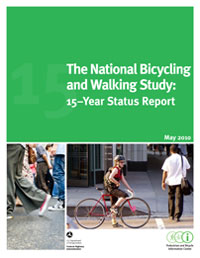

The progression of bicycling and walking in the United States

In 1994, the U.S. Department of Transportation (U.S. DOT), Federal Highway Administration (FHWA) and the National Highway Traffic Safety Administration (NHTSA) conducted an extensive study highlighting the conditions of bicycling and walking in the United States. The study implemented 24 case studies to analyze the state of walking and bicycling across the country with two primary objectives outlined — to determine the current levels of bicycling and walking and to identify reasons why they are not more often used as a means of transportation.
Once the initial study was finalized, the U.S. DOT established two overall goals: To double the percentage of total trips made by bicycling and walking in the United States from 7.9 percent to 15.8 percent of all travel trips, and to simultaneously reduce the number of bicyclists and pedestrians killed or injured in traffic crashes by 10 percent. So where does the state of bicycling and walking in the nation stand?
Since the first study, the Pedestrian and Bicycle Information Center (PBIC) — the national pedestrian and bicycle clearinghouse housed within the UNC Highway Safety Research Center (HSRC) — has released three status reports detailing the conditions of walking and bicycling in the U.S. Each of these reports has examined the levels of walking and bicycling. The recently released 15-year status report goes one step further than the past 5-year and 10-year reports and looks at the present efforts to impact the rate of walking and bicycling. The 15-year status report reveals the new progress made toward the goals of the 1994 National Bicycling and Walking Study. Taking a look at the 2009 National Household Travel Survey (NHTS), walking trips accounted for 10.9 percent of all trips and one percent of all trips reported were taken by bike; together accounting for 11.9 percent of all trips. Bicycling and walking combined attributed to approximately a 25 percent increase for both modes of transportation since the 2001 NHTS. The number of trips taken by bicycling and walking has more than doubled since 1990.
In regards to safety, the nation has witnessed a 12 percent decrease in pedestrian fatalities and a 22.3 percent decrease in fatalities among bicyclists between 1993 and 2008 (the last year data was available). NHTSA data indicates that there was a 17.8 percent and a 14.7 percent decrease in pedestrian and bicyclist injuries, respectively, between 1995 and 2008.
"While the goal of doubling the percentage of total bicycling and walking trips has not been met, an increase has occurred and the safety goal outlined in the 1994 study has been exceeded," says Laura Sandt, PBIC associate director. "We are really excited about the progress outlined in the report, but fully recognize the need for continued support of walking and bicycling."
In his blog "The Fast Lane" U.S. DOT Secretary Ray LaHood featured the 15-year report released by the PBIC. Secretary LaHood discussed the bicycling and walking gains outlined in the report and stressed the want and need of Americans to have alternative transportation methods to driving.
"That's why we recently announced a policy change that encourages transportation agencies to go beyond minimum standards and provide safe and convenient facilities for pedestrians and bicyclists," stated Secretary LaHood in his blog entry; addressing the new U.S. DOT policy for pedestrian and bicyclists accommodations. The 15-year status report also examines a range of efforts, including programs at the federal, state and local level, to increase bicycling and walking in the United States. Programs such as Safe Routes to School and pedestrian safety training courses for professionals emphasize the health, transportation and quality of life benefits of bicycling and walking. To access the full report, please visit http://www.walkinginfo.org/15_year_report/
The University of North Carolina Highway Safety Research Center
730 Martin Luther King Jr. Blvd, Suite 300 | Campus Box 3430 | Chapel Hill, NC 27599-3430
Phone: 919.962.2203 | Fax: 919.962.8710
http://www.hsrc.unc.edu